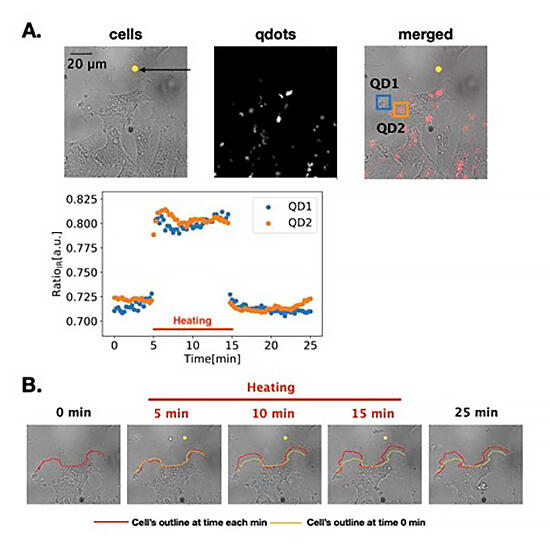A research group comprised of Professor Noriko F. Hiroi of the Faculty of Creative Engineering, Kanagawa Institute of Technology, graduate student Takayuki Nakamura of the Graduate School of Science and Technology, Keio University (at the time of research), Professor Akira Funahashi and Senior Lecturer Takahiro G. Yamada of the Department of Biosciences and Informatics, Keio University, Assistant Professor Kohki Okabe of the Graduate School of Pharmaceutical Sciences, the University of Tokyo, Professor Makoto Tominaga and Associate Professor Shigenori Nonaka of the Exploratory Research Center on Life and Living Systems, and Associate Professor Yasuhiro Kamei, Assistant Professor Jo Sakamoto, and Dr. Atsushi Taniguchi of the National Institute for Basic Biology, has successfully measured, using two different measurement principles, that the temperature of cells migrating to close wounds is over 1°C higher than that of non-migrating cells. Furthermore, the group warmed immobile cells with an infrared laser, and obtained data showing that those cells began moving when they were warmed.

Courtesy of Kanagawa Institute of Technology
The research group focused their attention on the wound healing assay system, a cell culture system that mimics the wound healing process. Using cell culturing, the group measured the temperatures of leader and follower cells. To ensure that the results of those measurements were not errors rooted in the measurement methods themselves, the group used two different measurement methods, one being Fluorescence Lifetime Imaging Microscopy, using an organic polymer, and the other being wave length shift dependent on the temperature change of nano-scale semiconductors.
The results of both measurement methods confirmed that leader cells, the first to move to close the wound, have a temperature between 1 and 10°C higher than follower cells that either remain immobile, or later follow the leader cells. Accordingly, the group learned that the high temperature phenomenon of the leader cells over the follower cells could be confirmed using different measurement methodologies, demonstrating that it was not rooted in the margin of error of a specific measurement method. This finding serves as solid evidence that differences in temperature can exist in the small spaces of individual cells.
To further explore the physiological significance of the temperature differences, the group directed an infrared laser with a wavelength of 1,480 nm near the cell to invoke a temperature rise without damaging it, rather than creating a wound on the cell sheet. This experiment confirmed that the space within the cell was warmed by the laser light, and the group observed that at the same time, the warmed cell began to deform and move.
This demonstrates that warming the cell may play a role in causing it to start moving and to maintain that motion. This suggests that temperature differences within tiny spaces within a body may play a physiological role in attempting to heal wounds.
According to Professor Hiroi, "It may be possible to use a heat signal as a treatment for aged cells to regain their original activity. Our findings demonstrated that heat is useful information in manipulating the mechanisms of living organisms as a factor in basic science, so we hope to systematize our knowledge of the mechanisms by which cell temperature is raised and maintained, and the effects the temperature changes have on the high concentration of proteins in the cell and summarize that knowledge under the science of Biothermology."
This article has been translated by JST with permission from The Science News Ltd.(https://sci-news.co.jp/). Unauthorized reproduction of the article and photographs is prohibited.




